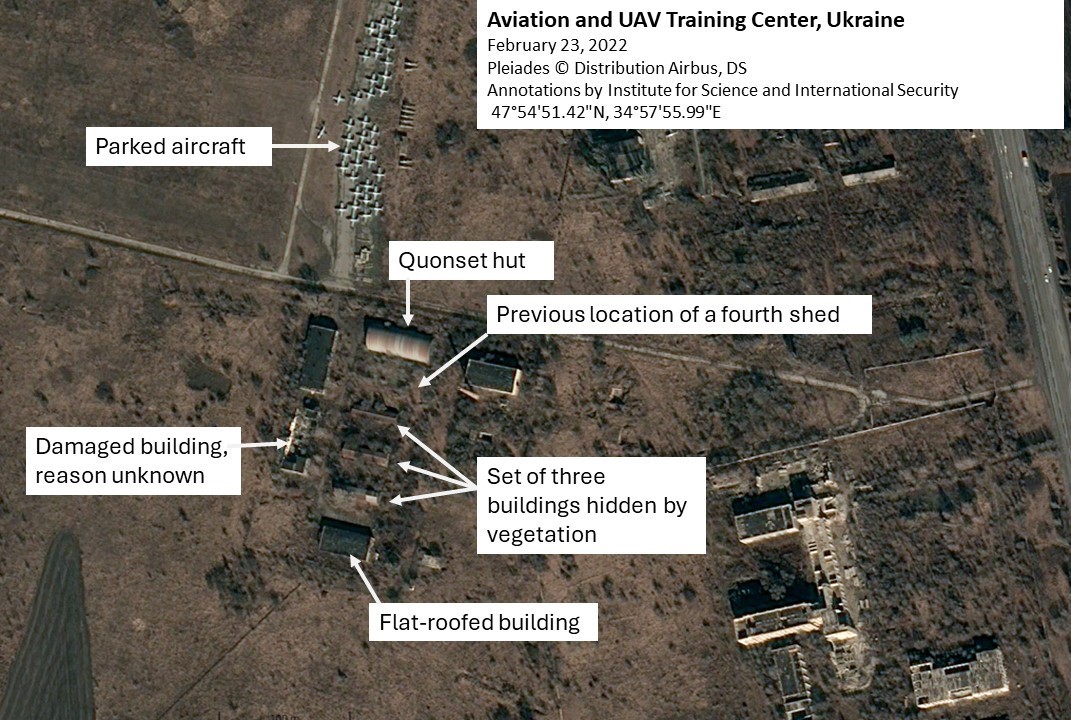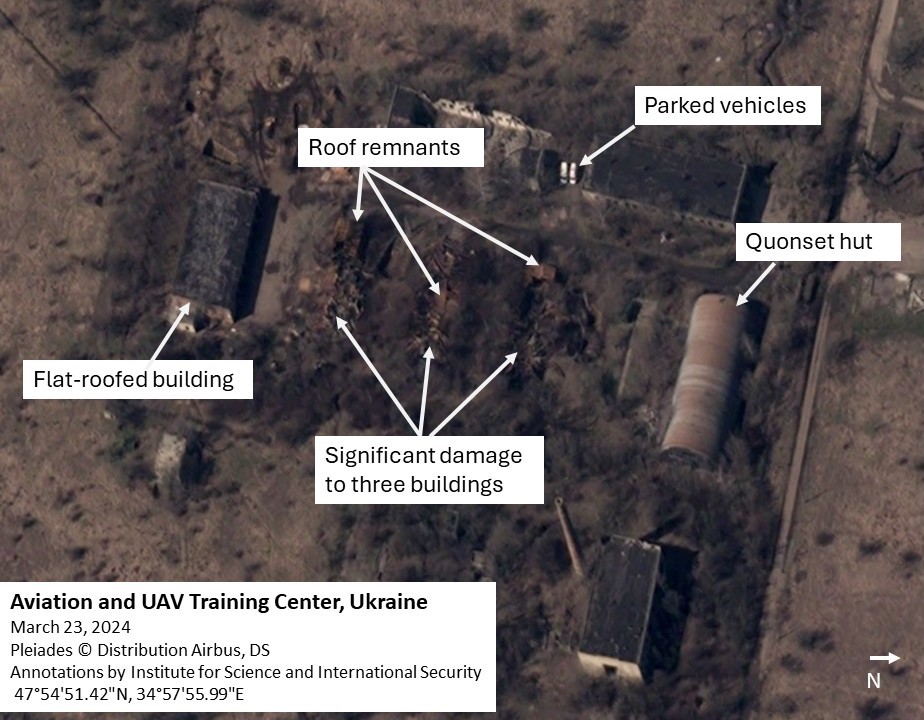Recently leaked documents from an unknown source indicate that JSC Alabuga (Alabuga) is contracting with Russian enterprises to make thousands of warheads for Shahed 136 kamikaze drones, as a critical part of Alabuga providing the Russian army with significantly more drones than initially planned. The source shared the documents with various groups, including the Telegram channel Russia No Context and the Ukrainian publication Defense Express, which published copies of the documents.[1] Their authenticity could not be directly confirmed, but they appear consistent with other information, including battlefield reports and earlier leaked Alabuga documents.
Alabuga had originally planned to make the warheads itself after receiving a few thousand warheads from Iran under a $1.75 billion dollar contract with Iran to enable Alabuga to supply 6000 Shahed 136 drones to the Russian army. Figure 1 shows a schematic of the Shahed 136 drone, aka Geran 2 drone, from internal JSC Alabuga documents. Under the franchise contract with Iran, Alabuga received about 600 disassembled Shahed 136 drones, training, the technology, and much of the equipment to make these drones, and an initial set of drone components, including the warheads, engine, and electronic components, sufficient to build almost 1350 more drones. Afterwards, the contract called for Alabuga itself to be responsible for providing the internals, including the warhead, to make over 4000 more drones. This report focuses on Alabuga's transition to domestic warhead production, insights into the types of warheads Alabuga has sought, and its ramped up production of Shahed 136 drones, indicating its strategy of outsourcing warhead production within Russia is working.
Although it cannot be excluded that Alabuga will continue to buy some number of warheads from Iran, Alabuga appears to be contracting with multiple Russian enterprises to make almost 10,000 warheads for its drones. Because these enterprises have decades of experience making warheads for other military systems, this decision opens a door to more sophisticated warheads, likely at a reduced cost compared to self-production. These enterprises are uniformly sanctioned by the United States. A cursory examination of the imports of one of these companies showed extensive reliance on Chinese suppliers for the raw materials used in its warheads. One specific design further appears to depend on SHX steel balls, which are proprietary to a Japanese company named Motion and Control NSK.
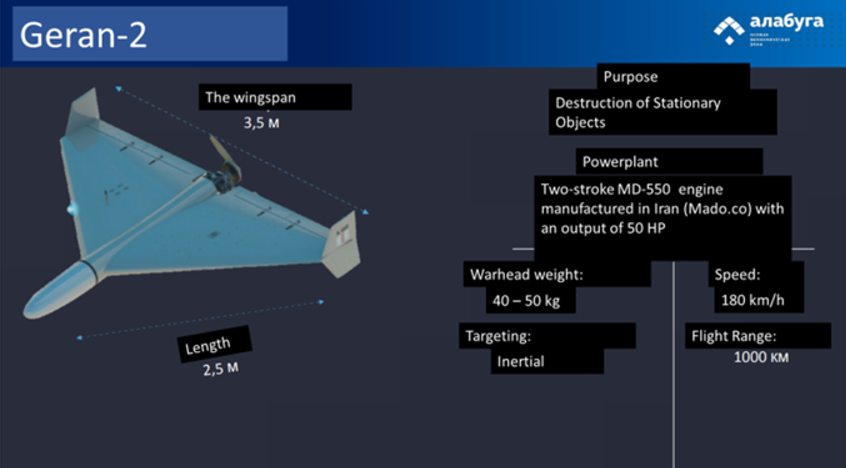
Figure 1. Translation of a slide in an internal late 2022 or early 2023 Alabuga presentation about the Shahed 136 kamikaze-type drone, aka Geran 2, as provided by Iran, where a 40 - 50 kg warhead is at the front of the drone. This slide is from an earlier leak.
The leaked documents highlight JSC Alabuga's ambition to obtain far more and deadlier warheads than the ones in the original order from Iran. The bulk of the domestically produced warheads appear to have increased fragmentation-high explosive-incendiary effects that can increase the destruction of infrastructure, complicate repairs, and kill more people. Alabuga has tested a warhead with almost double the explosive yield, with a greater penetration capability. It is considering mass production of thermobaric warheads for the Shahed 136, aka thermobaric volumetric explosive munitions, which cause increased blast overpressure and greater temperatures than traditional warheads. When used against buildings, bunkers, and cities, they cause more destruction and casualties.
The slides also show Alabuga interested in buying warheads for the Shahed 236 Seeker drone. Sold by Iran, this kamikaze drone can select targets during flight.
Ukraine has increased its efforts to harden key sites, like electrical infrastructure, to be more resistant to Russian bombardment, but it is unclear if it is keeping up with Alabuga advances. [2] One priority solution is more air defenses. The Shahed 136 can be brought down, as Iran's recent experience shows when it lost all such drones before they reached Israel. However, not enough Shahed 136 drones are being destroyed in Ukraine to prevent significant damage. The percentages of downed Shahed 136 drones has varied from 50 to 100 percent, with typical percentages being 80 to over 90 percent. With the recent dwindling of defense measures, Ukraine had a lower percentage of interceptions for Russian drone attacks in February and March 2024, based on daily figures published by the Ukraine military. To establish consistent interception rates over 90 percent, the West needs to supply considerably more air defenses that include effective kinetic responses, including advanced attack aircraft and anti-aircraft batteries, and more effective and more numerous jamming and spoofing equipment.
Initial Contract and Plan: Bumpers and Accelerators
In early 2023, JSC Alabuga agreed to buy the Shahed 136 manufacturing capability from Iran, at a total cost of $1.75 billion. One of the key components was the high explosive warhead (see Figure 1). In their correspondence, from an earlier leak, they called this the "bumper," aka "eco-bumper," and "accelerator". An early 2023 Alabuga excel spreadsheet, also from an earlier leak, lists all the major components of the Shahed 136, including the bumper and accelerator, where the latter appears to be a fuze or igniter and detonator for the warhead. Table 1 lists the names and associated components of the bumper and accelerator, as listed in the original excel spreadsheet translated from Russian by DeepL.
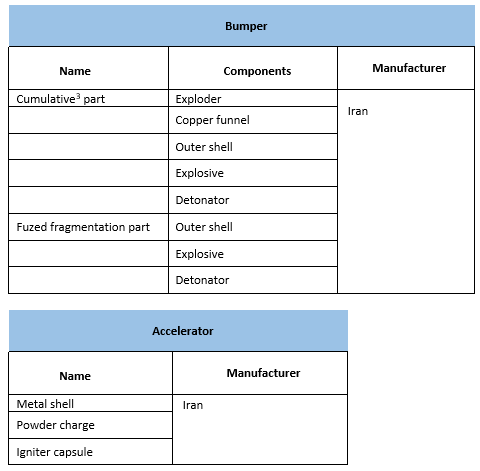
Table 1. Parts of the Iranian-supplied warhead for the Shahed 136. Original in Russian. [3]
Given that these parts were listed as manufactured in Iran, it makes sense that they use Iranian designs and high-explosive and ignition and detonation systems. However, Alabuga was still responsible for the final assembly of the drone. Surprisingly, available documents do not include procedures for the safe handling of the warheads and firing mechanisms, and initially, Alabuga took delivery of the warheads and mated them with the drone body at Alabuga without applying standard Russian high explosive safety regulations, according to available information. While the warhead has some Iranian-designed features to reduce the risk of accidental explosion until the drone is airborne, it appears that Iran's safety standards were notably lower than Russia's.
A February 2023 report by Conflict Armament Research (CAR) sheds additional light on the Iranian-supplied warheads. [4] Figure 2 shows a multipurpose cylindrical warhead from a Shahed 131 drone, approximately 50 centimeters in length and a diameter of 16 centimeters. It is likely similar to the Iranian-supplied warhead for the Shahed 136 drone. It is designed to cause extensive damage to infrastructure while having "two pre-serrated fragmentation matrices, each made of 11 layers of fragmentation cubes, around the forward and rear sections of the warhead" to harm people. In this report, CAR also reported on a reinforced casing of a Shahed 136 drone designed to allow the warhead to penetrate a structure before detonating.


Figure 2. A multipurpose warhead from a Shahed 131 drone. The copper discs visible in the left image are used to create radial anti-armor effects. Two fragmentation belts composed of eleven layers of metal cubes (type not provided) are also visible in the left image. There is a primary cone-shaped liner in the forward section of the warhead (see right image), which corresponds to the copper funnel in the bumper's parts list. Source: Conflict Armament Research (see footnote 4).
The Alabuga/Iran contract includes an agreed upon schedule for Alabuga to make the warheads itself. Under this schedule, Alabuga planned to install a production line to make bumpers and accelerators for the Shahed 136 in the late spring of 2024. Based on the contract's schedule, which covers both Iranian actions and Alabuga payments, Alabuga was to receive extensive technical training from Iran on bumper production early on, from May 2023 to June 2024. [5] A late 2022 or early 2023 Alabuga PowerPoint contains a design for a high explosive production facility under a slide called "Production layout of the combat unit," comprising 16,000 square meters (see Figure 3). It has a hexagonal layout with various production steps at each corner of the hexagon, separated by roads of over 100 meters in length, with remote control and energy supply located in the center.

Figure 3. Translation of an Alabuga layout for a high explosive production facility to make Shahed 136 warheads, taken from an Alabuga PowerPoint presentation from late 2022. The acronym BB stands for explosives in Russian.
Based on assessing commercial satellite imagery of a wide area surrounding Alabuga Special Economic Zone, Alabuga did not as of April 2024 appear to have any such external facilities as described in Figure 3 to make high-explosive warheads. Although Alabuga may still decide to build such a facility for Shahed 136 drones, the evidence in downed drones in Ukraine currently indicates that Alabuga decided to contract with Russian companies with expertise in making warheads, a step that apparently also opened the door to ordering more sophisticated, more varied warheads from Russian enterprises with decades of experience in making warheads and bombs.
One of the first possible indications of a more sophisticated, domestically produced warhead was revealed in the fall of 2023, when the Ukrainian military's Centre for Research of Trophy and Advanced Weapons and Military Equipment stated in a briefing that it had found a new version of the Shahed 136 warhead. The briefer stated that the warhead has a fundamentally different shape and is packed with tungsten balls, achieving a more effective way to produce shrapnel than the earlier blast fragmentation warhead.[6] The briefer stated that the writing on this tungsten warhead is in Cyrillic, implying a Russian manufacturer. While it cannot be excluded that Alabuga produced this warhead, the absence of a suitable production facility at Alabuga would imply another Russian enterprise produced it.
Information in slides in this recent leak show additional work on Shahed 136 warheads. The slides are undated, but based on the information contained in the slides, they likely date to no later than the end of 2023. In these slides, the nomenclature for the standard warheads is Warhead 50 kilograms, or Warhead, aka BC-50 or BCh-50. (The Cyrillic бч translates as a word to warhead but is also translated into English as an acronym BC or more commonly BCh. бч appears to also be shorthand for боевая часть, which also translates as warhead.) Another warhead is under consideration, Warhead 90 kilograms, or Warhead 90, aka BCh-90. The respective numbers refer approximately to the mass of their warhead. Figure 4 is from this PowerPoint, showing each warhead in the drone and summarizing some of the modifications needed to fit the Warhead 90 into the drone, including relocating the warhead further inside the drone and relocating the electronic components (see also Figure A1 in the Annex). These relocations are related to maintaining as much as possible the drone's center of mass, as shown in another figure in the recent leak that discusses optimizing the drone's alignment and the maximum preservation of its flight characteristics. This redesign also led to modifications in the fuel tank, in particular resulting in a smaller fuel tank. Overall, the changes resulted in a reduction in the drone's range to 650 kilometers from a reported 1350 kilometers for the standard warhead drone.

Figure 4. The slide is titled: "Installation of the Warhead 90, Changing the location of the BREA units" [BREA, identified in orange in the slide, is an abbreviation used for the electronic components in a Russian drone]. The front cylinder part of the drone is barely visible in the image. The warhead 90 is set further back than the Warhead 50 (see also Figure A1 in Annex). This allows minimal changes in the flight characteristics of the Shahed 136 drone, although they do reduce the range of the drone. Source: Russia No Context.
Figure 5 is a slide further comparing the two warheads. Warhead 90 has evidently not been routinely deployed on the Shahed 136, although it has apparently been tested in combat (see below).
Warhead 50, or standard warhead, appears to be the original Iranian design, a type referred to as "OF + Cumulative" in the slide in Figure 5, or likely fragmentation-high explosive plus Cumulative. The OF contains 2.5 kg of explosives for a total mass of 3.5 kilograms and the cumulative part has 25.5 kg of explosive for a total mass of 28 kg. The total bumper mass adds to 53.5 kg. The copper funnel appears to be in the smaller component in the front piece of the warhead. Missing in the figure are copper discs and fragmentation elements on the side of the warhead as seen in Figure 2, although a covering is also missing in figure 5, indicating that only certain parts of the warhead are highlighted in the schematic.
By contrast, Warhead 90 (BCh-90), designated as type офбз [transliterated as OFBZ], has 62 kg of explosive and a bumper mass of 92 kilograms (see Figure 5). Its design appears to differ markedly from that of the Warhead 50, although there are similarities. It has fragmentation elements surrounding outer parts of the warhead, called "912 ст45" [likely ST45 steel] and "3000 Zirconium," where these parts are for both fragmentation and increased incendiary effects.[7] It appears to have a larger copper funnel than Warhead 50 which would cause greater armor penetration or at least increased penetration on initial contact. It is unclear in the slides who makes this newer warhead, although see below.
According to the slide in Figure 5, Warhead 90 is 170 percent more powerful than the standard warhead. Figure 5 also includes images of the Bryan Mound Oil Storage facility in Texas and a building of CHPP-6 in Kyiv, a 500 megawatt gas-fired power project. Circles in the images compare the projected radii of destruction of each warhead on these facilities.

Figure 5. Comparison of Warhead 50 and Warhead 90. The casing is missing in Warhead 50. The eighth row in the table (not counting the header row) translates as the radius of the explosion, and the values in columns 2 and 3 appear to correspond to the three different radii of the effects of the explosions (by color) in the image on the right side of the slide. The ranges listed in this slide for the Warhead 90 are longer than in another slide discussed, but not shown, above. But no explanation for the difference in ranges is offered. Source of Slide: Defense Express.
Combat Applications of Warhead 90
Two slides discuss the combat application of Warhead 90. The first is titled, "Combat Application of Warhead 90, Route No. 1, 25.11.23 - 581.6 km." See Figure 6. This slide shows the circuitous flight path of a drone to its target, taken on November 25, 2023, according to the date in the title. The second slide (Figure 7, top image) is titled, "Objective control of the result of hitting the target. Target along routes Nº1, Nº2, Object: UAV Base + UAV Operator Training Center." It shows the exact location of apparent damage at the site shown in the previous slide.

Figure 6. The title of the slide is "Combat Application of Warhead 90, Route No. 1, 25.11.23 - 581.6 km." It shows the circuitous route followed by the drone after its launch. The launch point is near or at the Yeysk Airport, which is north of the Primorsko-Akhtarsk airport, a region from which many Shahed drones are launched. Source: Russia No Context.
Using the map and the translation of the slide, the Institute was able to locate the targeted site as an aviation and UAV training center in Ukraine just west of the Dnipro river, near Zaporizhzhia. A high-resolution Airbus Pleiades Neo satellite image of the site pre-dating the attack, taken on February 23, 2022, shows the site in more detail (see Figure 7). Another image from August 2023 (not shown) shows the site intact. The high resolution of the February 2022 image allows for the identification of three buildings that are hidden by canopy. Two of the three buildings in the top image in Figure 7 are marked in green in the PowerPoint, presumably as targets.
There was a large attack by Shahed drones on the night of November 25, 2023, mostly in the Kyiv region but also in the area of Zaporizhzhia.[8] However, 74 out of 75 drones were reportedly shot down. The Ukrainian Air Force command stated on social media that the drones were launched from two directions, Primorsko-Akhtarsk, Russia and the Kursk region, Russia, consistent with the flight path shown in Figure 6.

Figure 7. Top image is a PowerPoint slide titled, "Objective control of the result of hitting the target. Target along routes Nº1, Nº2, Object: UAV Base + UAV Operator Training Center." Source: Russia No Context. The bottom image is a high-resolution Airbus Pleiades Neo satellite image of the site pre-dating the attack, taken on February 23, 2022. It shows the site in more detail, allowing for the identification of three buildings that are hidden by canopy. One other building appears damaged for unknown reasons, and one shed appears to have been removed in this image pre-dating Russia's invasion of Ukraine.
A high-resolution Airbus Pleiades Neo image taken after the alleged attack, in March 2024, shows the three camouflaged buildings largely destroyed, with only remnants of the roofs still visible. See Figure 8. It appears that the attack was carried out in the manner described in the PowerPoint, namely targeting the two buildings flanking the middle building, where the blast radius was large enough to also damage the building in the middle.
Of note, the image in the Alabuga PowerPoint allegedly showing post-attack damage is not a real image but instead appears to be an edited image pre-dating the attack used to showcase the damage. As such, the March 2024 image confirms that the buildings encircled in green were damaged, but a lack of high-resolution imagery closer to November 25, 2023, means we cannot confirm that it occurred on November 25, 2023, versus at another date.
Figure 8. A high-resolution Airbus Pleiades Neo taken in March 2024 shows the three camouflaged buildings were largely destroyed, with only remnants of the roofs still visible.
Making Advanced Warheads in Russia
One of the recently released PowerPoint slides discusses several Russian enterprises and their warheads considered for large-scale production (see Figure 9). The title of the slide is "Work with Enterprises of the Russian Defense Industry." This slide does not have the Alabuga header, but in the case of one warhead, partnership with Alabuga is explicitly mentioned. In addition, Defense Express labelled the slide as part of the Alabuga data leak. The slides lists four types of warheads, still subject to approval by the government, likely the Ministry of Defense. There is no schedule for the production of these warheads in the slides or explicit mention of the recipient, although the characteristics of the warheads indicate their use in drones being built or sought by Alabuga. The slide is likely dated to sometime in the latter half of 2023.

Figure 9. Slide Title: "Work with Russian Federation Enterprises on Warheads." See text for translations of table. Source: Defense Express.
Figure 9 lists the production of four warheads, their manufacturers, and the quantities desired. It is summarized and added to below:
1) Thermobaric warhead, where the customer provides the raw materials for modification. [9] The manufacturer would be Scientific Research Institute of Applied Chemistry, which is a leading enterprise in Russia in the field of research, development, production and utilization of pyrotechnic products for military and civil purposes. It would supply 3000 warheads. In case of approval [by whom, not stated, but likely government], the order would need the allocation of the product GOST RV1376-012-2008 in the amount of 54 tons from the reserves of the Federal Agency for State Reserves "Rosreserv." GOST RV1376-012-2008 is a category of explosives obtained after disposal of unexploded ordnance, a great deal of which Russia has recovered in Eastern Ukraine. Based on another slide, this warhead appears to have a mass of about 52 kg (see Figure 11).
2) Fragmentation-high explosive-incendiary warhead assembly. The manufacturer would be Joint Stock Company Research and Production Association Basalt (JSC NPO Basalt), a leading Russian defense enterprise for the creation and supply of weapons and ammunition. It would provide 5000 warheads. In case of approval, the order would require the allocation of the product GOST RV 1376-011-2008 in the amount of 85 tons from the reserves of the Federal Agency for State Reserves "Rosreserv." This is octogen, which is better known as HMX, a powerful and relatively insensitive nitroamine high explosive. Based on another slide, this warhead appears to have a mass of about 50 kg (see Figure 10).
3) Special bumper for the Seeker drone, which is described in earlier leaked documents as a propellor-driven Shahed 236, aka MS 236, with a warhead of explosive components and a homing device with a combined mass of 50 kg. Alabuga indicated to Iran in early 2023 that it was interested in buying 2130 of these drones, although no schedule is available. The bumper would be smaller than others and would be sufficient to defeat lightly armored vehicles. The manufacturer would be the Scientific Research Institute of Applied Chemistry, and 2000 warheads would be supplied. In case of approval, the order would need the allocation of the product GOST RV1376-012-2008 in the amount of 54 tons from the stocks of the Federal Agency for State reserves "Rosreserve." This is again recovered explosives from unexploded ordnance. It is the same amount as is in bullet 1, which could be explained by the different explosive needs of a thermobaric warhead.
4) 90 kg fragmentation-high explosive-incendiary warhead. The manufacturer would be the Joint Stock Company "State Scientific Research Institute of Mechanical Engineering'' named after. V.V. Bakhireva (aka JSC GosNIIMash or AO Gosniimash IM. Bakhireva), which is a leading organization in the field of the development of warheads for guided missiles. It would first provide a test run of 30 warheads followed by 1000 more. Ministry authorization is required for GosniiMash to work with SEZ Alabuga. This appears to be the warhead in Figure 4 and Figure A.1 in the Annex and used in a test combat operation, discussed above.
All three companies are sanctioned by the United States. At least one can be shown to use raw materials imported from China. A survey of trade data for imports by the Scientific Research Institute of Applied Chemistry showed 36 shipments from June 2021 to October 2023, involving hundreds of thousands of kilograms of chemicals used in pyrotechnics and explosive compounds. Nearly all the shipments were sent to the company's address in Moscow by Chinese companies. One shipment was sent by an Uzbekistan company.
Warhead Counts and Types of Drones from Iran
The number of warheads being considered in Figure 9 is large, compared to the Shahed 136 order of 6000 drones to be built by September 2025. However, Alabuga appears to have stepped up its rate of Shahed 136 production and is supplying the Russian military with more drones, including possibly additional drone types based on Iranian supply and assistance. An internal Alabuga trip report, leaked earlier this year, summarizes a visit to Iran from April 4 to April 8, 2023, to purchase three drone types and their associated technology and to receive training. The drones have been designated as the Shahed 236 Seeker (aka MS 236, with guidance system), the Shahed 236 Jet (aka M 237 (jet)), and the 107B or 107C (scout/kamikaze).
A few of the MS 237 drones have been used against Ukraine, but it is not known whether Alabuga followed through on its plans and purchased all these drones in the numbers envisioned. The new warhead information suggests that Alabuga was actively preparing to receive these drones.
Table 2 lists the various drone types being built, purchased, or sought by Alabuga. According to the April 2023 Alabuga trip report, the M 237 Jet carries a 50 kg warhead and is designed to be a kamikaze drone, but given its speed acts more like a cruise missile than a conventional drone. The MS 236 Seeker's warhead is also 50 kg, but it contains both a homing device and an eight-kilogram warhead. The warhead for the 107B/107C drone does not appear to be discussed in the newly leaked documents. The bulk of the warheads in Figure 9 will be for the Shahed 136 drones.
Based on the number of drones launched by Russia, a number monitored by the Ukrainian Air Force, a number larger than the amounts included in schedules in the Alabuga/Iran contract, Alabuga supplied almost 3000 of 6000 Shahed 136 drones by the end of December 2023, where about 600 are disassembled Shahed drones provided by Iran to Alabuga. This assumes that the Ukrainian Air Force can differentiate between Shahed 136 and Seeker drones, which look similar. This leaves 3000 to be produced. Internal Alabuga Shahed project documents further state that it wants to make a total of 10,000 Shahed 136 drones. This indicates that Alabuga is planning on making 7000 more Shahed 136 drones.
The Alabuga/Iran contract does not include enough Iranian warheads to meet the production of Shahed 136 drones through December 2023. Under the original contract, Iran agreed to provide 1332 warheads by early 2024, all of which would be fitted into airframes made by Alabuga. This is far short, almost 1100 warheads short, of the estimated 2300 warheads needed by the end of 2023 to fit into airframes manufactured by Iran. This implies Alabuga bought more warheads from Iran or was already buying a significant number of warheads from other Russian enterprises. There is some evidence that Alabuga was not obtaining enough warheads from Iran and instead was scraping for warheads in the fall of 2023. Defense Express reported the discovery of a warhead for the Shahed 136 drone that was repurposed from an existing air-launched missile. This implies that Alabuga was actively exploiting domestic sources of warheads in the fall of 2023. Its need for domestically produced warheads as exemplified in Table 9 seems urgent as of the fall of 2023 because of its stepped-up production. This also implies a date for the slides in 2023 rather than this spring 2024.
By late 2023, Alabuga is estimated to have achieved a production schedule of close to two shifts per day, producing about 20 drones per day. This estimate is based on considering the Ukrainian military's published values for Shahed launches, which are reported daily and cumulatively, periodically. In earlier leaked internal Alabuga documents, the main production hall was set up to produce 10 drones per shift, but it was expected to produce fewer in the Alabuga/Iran contract. Instead, Alabuga appears to have ramped up production faster than initially planned.
At the rate of 20 drones per day, and assuming a five-day work week and 52-week operation, the plant could produce about an average of 435 per month or about 5200 drones per year. At this rate, Alabuga could produce 7000 more Shahed 136 drones in less than a year and a half. The Shahed 136 warheads could be either the standard 50 kg or 90 kg warheads or thermobaric warheads. The Shahed 237 Jet drone could receive either the 50 kg standard warhead or thermobaric warheads. Table 2 summarizes these values.
How does this compare to the totals in Figure 9? The values for the Shahed 236 seeker line up well. The Shahed 136 and Shahed 237 Jet drones require 7677 warheads, and Figure 9 lists 8000-9000 suitable warheads. These values line up as well. The planned surplus of warheads leaves room for additional production of drones, some flexibility in choosing between types of warheads, or difficulties in meeting warhead production goals. But it would also mean no more warheads from Iran at all.
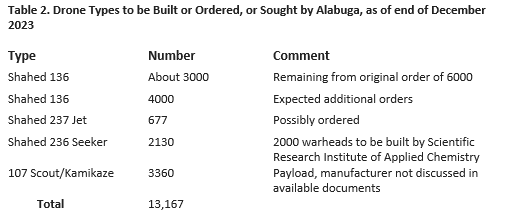
More Details on Warhead Types Discussed in the Leaked Documents
Figure 10 shows two warheads discussed in PowerPoint slides published by Defense Express. The bottom image is a 50 kg fragmentation-high explosive-incendiary warhead to be manufactured by JSC NPO Basalt with apparent involvement of Technodynamics, or Technodinamika Holding. It may be the warhead discussed in bullet 2 above, although it has less high explosive than the Warhead 50 discussed earlier. It is designated as офзбч-50, transliterated from Russian as OFZBC-50, which apparently designates fragmentation-high explosive-incendiary warhead. The fragmentation of this warhead is in the casing, which apparently takes up much of its mass. The fragmentation-incendiary materials are not stated in the slide. The top image in Figure 10 is designated as офзбс-50, transliterated as OFZBS-50, and designed by JSC GosNIIMash. The meaning of the last two characters "бс" is unclear. It appears to have the same size and mass of the original Iran-supplied warhead. The warhead's bumper would be 50 kg and contain 25 kg of high explosive, along with 4000 pieces made out of a tungsten alloy to increase the warhead's fragmentation and incendiary effects. They are called "defeating elements" or explosive elements in the slide.
The thermobaric warhead has reportedly been used against Ukraine. [10] Figure 11 shows a slide of a thermobaric warhead, labeled as a "thermobaric volumetric explosive munition," and its characteristics from this recent leak, published by Defense Express. Although this slide does not have an Alabuga header, Defense Express reported the warhead as part of the Alabuga leak, and its mass is consistent with use in that drone. The warhead has a core of about 30 kg of high explosives, surrounded by about 20 kg of a thermobaric mixture and another high explosive charge of 3 kg. It is surrounded by fragmentation pieces made up of 2300 SHX steel balls (gray section seen on top and bottom of warhead in the figure.) SHX steel balls are proprietary to a Japanese company Motion and Control NSK. The slide states that the warhead has a radius of destruction for a barrack's wall of 19 meters and an 80 percent probability of destroying lightly armored vehicles at a radius of 32 meters.
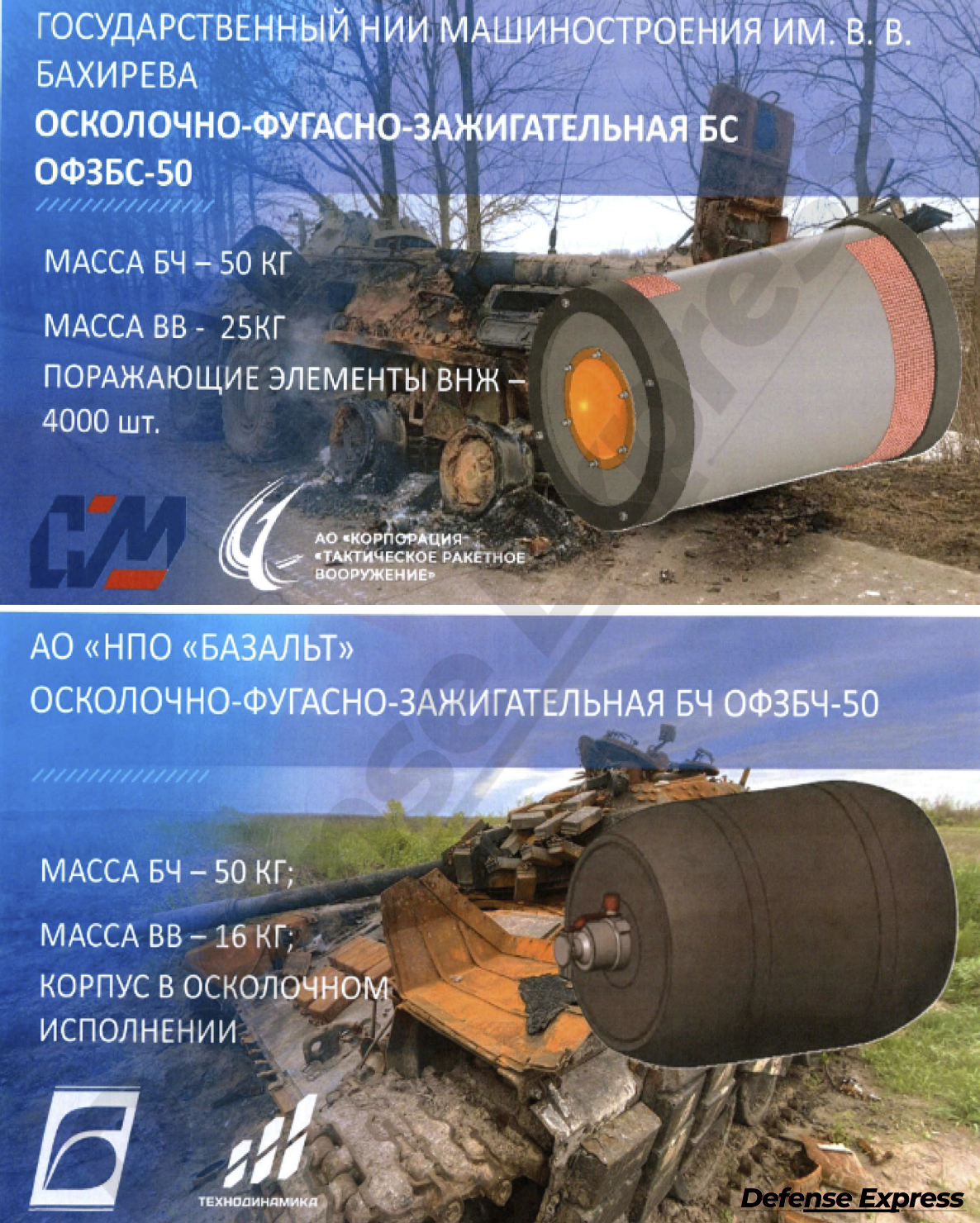
Figure 10. Two warheads each of 50 kilograms. The top image is designated OFZBS-50 and designed by JSC GosNIIMash. It is part of the JSC Tactical Missile Corporation, whose logo is in the bottom middle of the top slide. The bottom image is OFZBC-50, drawn from осколочно-фугасно-зажигательная бч [fragmentation-high explosive-incendiary warhead], designed by JSC NPO Basalt in collaboration with Technodinamika Holding (second logo on bottom left). The warheads differ in the amount of high explosive, 25 kg for top warhead and 16 kg for bottom warhead, and in the fragmentation method, but both have a warhead mass of 50 kg, suitable for the Shahed 136 or Shahed 237 Jet. Source: Defense Express.
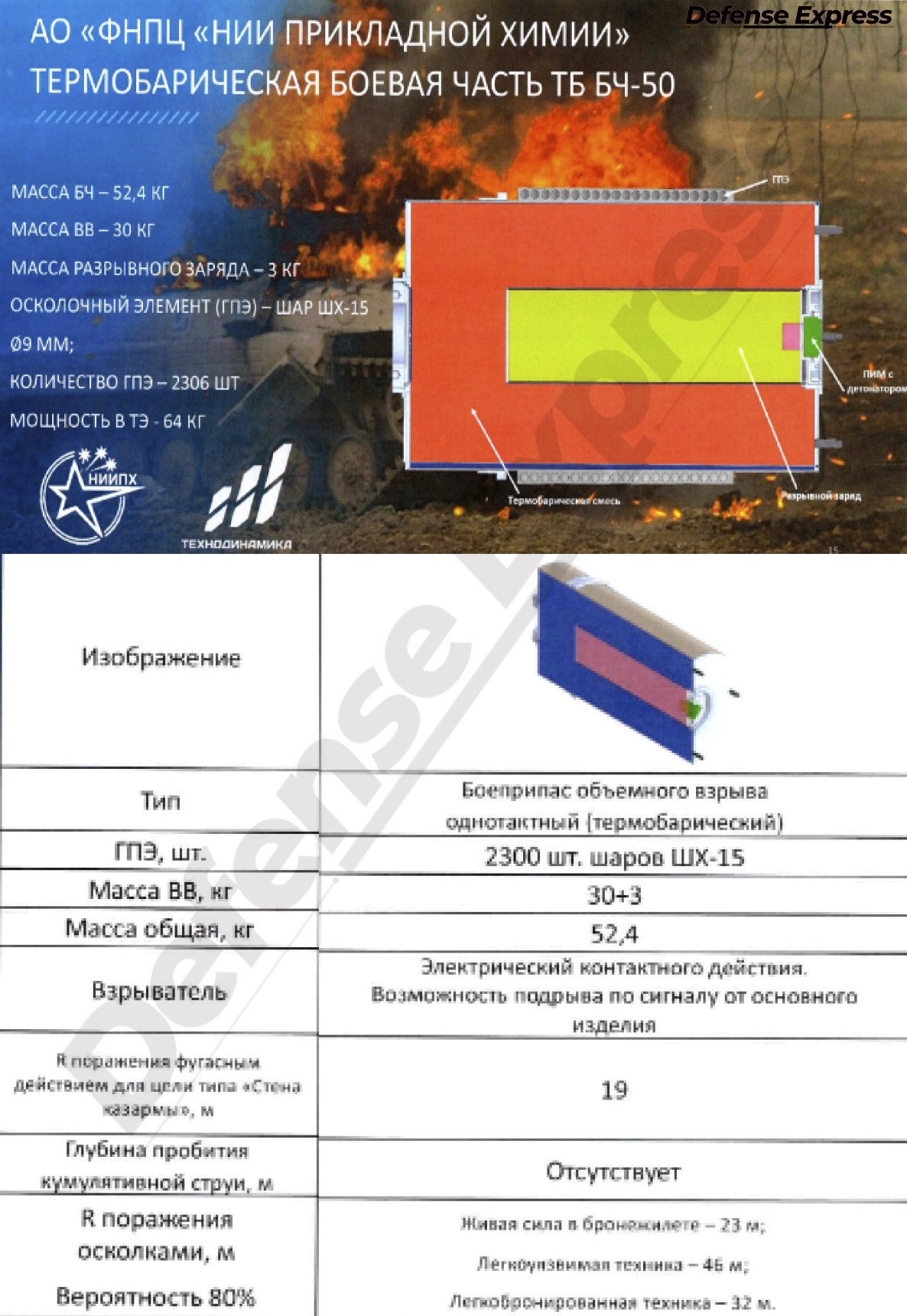
Figure 11. Thermobaric warhead characteristics. Translation of this slide and table is below. Source: Defense Express.
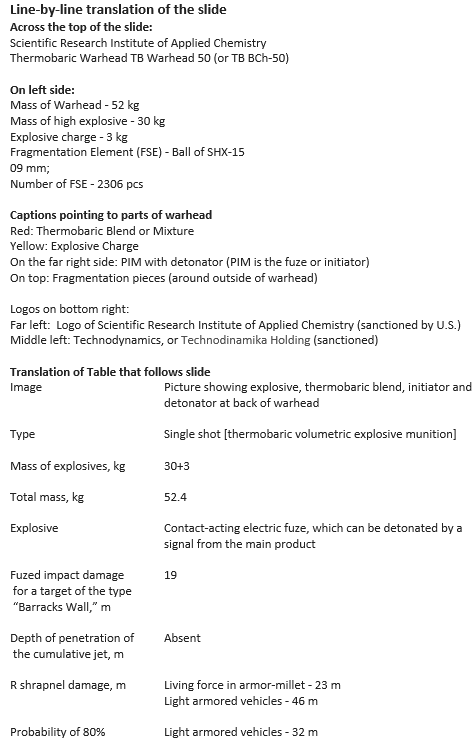
Annex Additional Slides
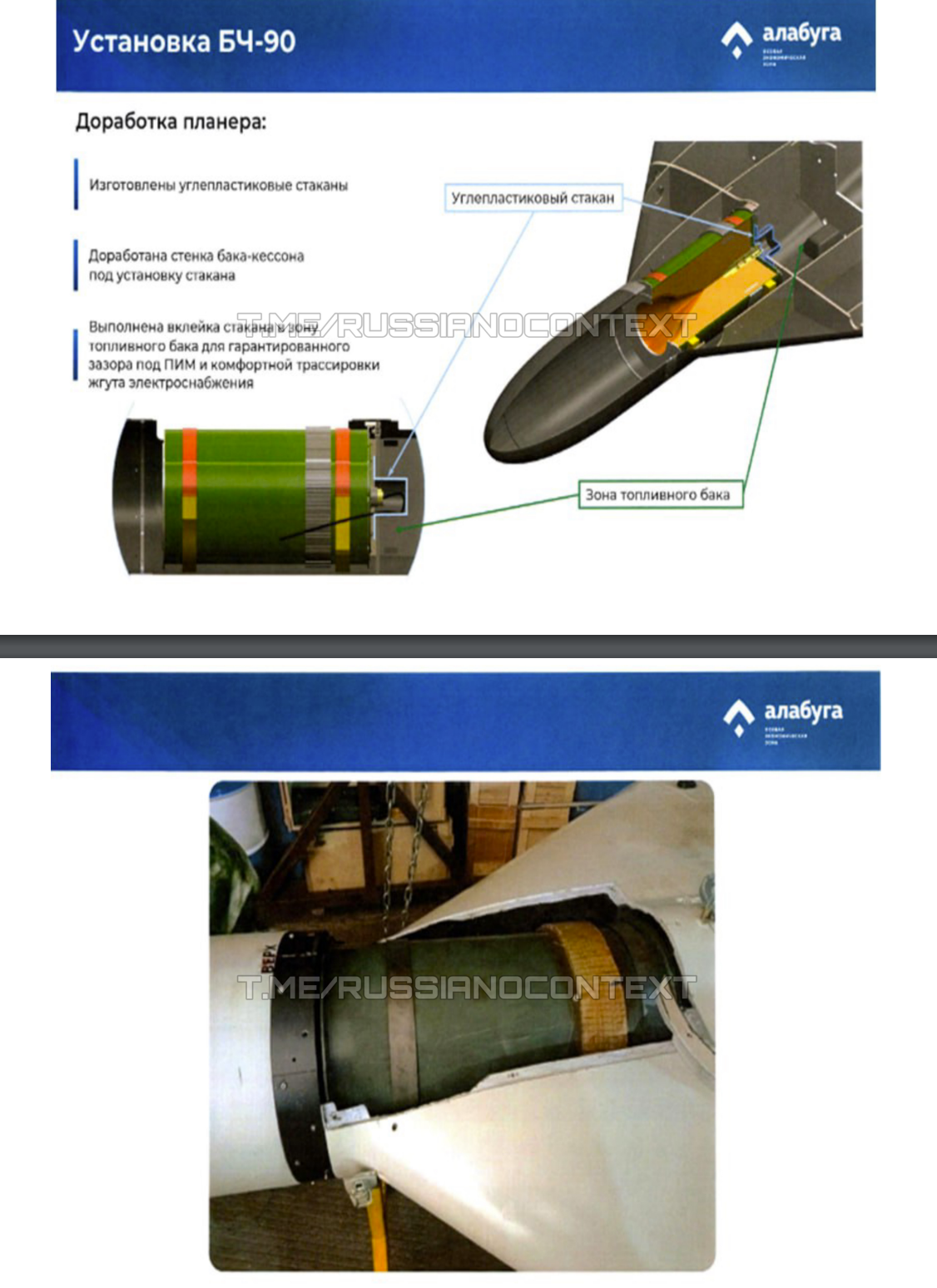
Figure A1. The top image shows the location of Warhead 90 and adjustments made in the drone's airframe design, including the modified fuel tank (behind the warhead; pointed out by a green line) and fabrication of a carbon fiber cap (in blue outline) over the PIM, which is the acronym for the initiator The bottom figure shows Warhead 90 in the drone with a hatch cover removed. A part of the cylindrical front of the drone is visible in the left of the image. Source: Russia No Context.
1. We want to acknowledge first of all the source, who is shedding important light on what amounts to a criminal enterprise to wreak havoc on Ukraine's citizens in an illegal war. Next, we want to acknowledge Russia No Context (T.me/Russianocontext) for posting many PowerPoint slides from this source. Last, we want to acknowledge the Ukrainian publication, Defense Express (https://en.defence-ua.com/), which published several excellent articles describing the slides, which it called the "Alabuga data leak". [↩]
2. Hannah Arhirova, "In Ukraine, power plant workers fight to save their 'child'," Associated Press, January 12, 2023, https://apnews.com/article/russia-ukraine-war-59883f5f68a517b560d94965566f9049.[↩]
3. Cumulative part of a warhead typically includes a housing, an explosive charge placed in the housing, and connecting parts. In the case of Iran, the cumulative part includes a copper funnel that after the warhead is detonated becomes a high speed, high energy, explosively formed penetrator. [↩]
4. Conflict Armament Research, "Field Dispatch, Multipurpose Iranian Drone Warheads Used in Ukraine," February 2022, https://storymaps.arcgis.com/stories/f5070c1d8ff8451c9a99138a3b70232d. [↩]
5. Pdf file name is CKDSKD production lines, which lays out a monthly schedule for tasks and payments, starting in January 2023 and ending in September 2025, by which time Alabuga would have supplied 6000 Shahed 136 drones, called motor boats in the schedule, and paid $1.75 billion. [↩]
7. See for example, "Incendiary Fragmentary Warhead," https://patents.google.com/patent/US4351240A/en. From the patent: "A warhead comprising an explosive charge surrounded by discrete individual metal fragments is increased in effectiveness by the addition of pyrophoric fragment material combined therewith. For this purpose, misch metal or zirconium-tin sleeves are placed around or within the fragmentation layers or, alternatively, a percentage of the ferrous metal cubes are replaced with a number of preformed zirconium fragments." [↩]
8. "Record Number of Enemy Strike UAVs Launched Against Ukraine This Night, Kyiv Main Target," Defense Express, November 25, 2023, https://en.defence-ua.com/news/record_number_of_enemy_strike_uavs_launched_against_ukraine_this_night_kyiv_main_target-8669.html. [↩]
9. Translator's note: the phrase in parentheses in the slide, наполние давальческих корпусов, пим, likely refers to the customer providing the materials for further modifications without transferring the property rights. Thus, the material remains in the possession of the customer. The abbreviation ПИМ [PIM], is a more obscure term, but it is used in other slides in the leaked set as part of the explosive detonation system. Another possibility in this context is the Product Information Management system, which is the collection and automation of information, in this case probably about the raw materials and any modifications. [↩]
10. See for example "Russia Enhances "Shahed-136" Combat Drones with Thermobaric Explosives," Defense Security Asia, December 7, 2023. https://defencesecurityasia.com/en/shahed-russia-thermobaric-explosives/. [↩]

